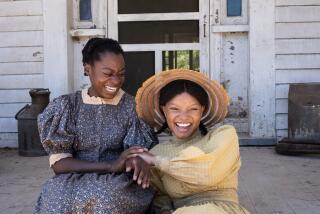The Story of Natalie Wood Is Also the Story of Her Mother
- Share via
One of the most striking things about Hollywood is the extent to which people all over the world came to regard it as the center of the universe. What the Holy Land was to true believers, Hollywood became to believers in make-believe.
One such believer was Maria Gurdin, who fled her native Siberia in the wake of the Russian Revolution, ending up in Northern California. A woman of immense drive and ambition, she found an inspiring contrast to the struggle of her daily life in the movies. Quite simply, she made up her mind that her second child, pretty, dark-eyed Natasha, was going to be a star. In 1943, when the little girl was just 5, Maria literally thrust her into pictures, instructing her to hop into the lap of director Irving Pichel, who was shooting a movie on location in the rustic town of Santa Rosa. Although little Natasha got a tiny part in “Happy Land,” the kindly Pichel tried to warn Maria that the film business was no place for a sweet little girl. Maria’s response was to move the entire family to Hollywood.
A sensitive, delicate child, quick to learn and desperately eager to please, Natasha became a child actress, playing a war orphan in the 1946 film “Tomorrow Is Forever.” When she was unable to cry on cue, her mother tore a butterfly to pieces in front of her, then pushed her sobbing daughter back onto the set. Given the more American-sounding name of Natalie Wood, Natasha, incessantly coached by her mother to do as she was told, soon became known as “one-take Natalie,” one of the most cooperative and professional young actresses in Hollywood. Even after the child had acquired a team of agents, Maria continued to micromanage most aspects of her career.
Only in her teens did Natalie begin to rebel, insisting on trying out for a role in the offbeat film “Rebel Without a Cause.” Unlike the cinematic antihero so memorably played by her co-star James Dean, Natalie had good cause to rebel, especially after her mother broke up her first serious romance with a high school sweetheart. (Maria had no such objections when her 16-year-old daughter spent unchaperoned nights with Hollywood VIPs.) Yet, for all the reasons she had to resent her mother, Natalie also recognized how much she owed her.
Suzanne Finstad, a lawyer and magazine writer whose previous books include a true-crime story, “Sleeping With the Devil,” and a biography of Priscilla Presley, presents a poignant, intensely sympathetic portrait of the vulnerable, sensitive little girl who grew up to be the quintessential Hollywood star, swathed in sable or mink, never seen in public without her makeup. Yet, as Finstad shows us, there was another side to Natalie: She wanted to become a serious actress, not just a star, and to this end she sought out opportunities to work with directors like Nicholas Ray and Elia Kazan, actors like James Dean and Scott Marlowe. “On the surface,” writes Finstad, “Natalie’s life seemed like a Sandra Dee movie fantasy of a teenage star ... in her cotton-candy-pink bedroom filled with toy tigers--gifts from male admirers.” Yet a lot of her private time was spent reading books like Nietzsche’s “Thus Spake Zarathustra,” the kind of books she would have read had she enjoyed the benefits of a college education.
Almost everyone who came into contact with Natalie (and Finstad has interviewed hundreds of them--childhood friends, actors, directors, costume designers, hairstylists) seems to have been impressed, not only by her intelligence and professionalism, but by her genuine sweetness. One of the few people who refused to be interviewed was Natalie’s husband, Robert Wagner. Finstad paints quite an insightful portrait of their relationship nonetheless. Only as the story moves toward its tragic conclusion do things grow murky. Natalie’s 1981 death by drowning in the waters off Catalina on a boating excursion with her husband and her co-star Christopher Walken on Thanksgiving weekend still remains something of a mystery. Finstad offers detailed accounts of the testimony of various witnesses--waitresses, a bartender, restaurant patrons, people in a nearby boat, and, most troubling of all, the man who captained the Wagners’ vessel--to what was clearly a strained, unpleasant weekend in which huge quantities of alcohol were consumed. What seems clear from Finstad’s account is that when faced with a genuine emergency Wagner’s first instinct was to be more afraid of negative publicity than of losing his wife. And the flight from truth rippled outwards. In time-hallowed Hollywood fashion, make-believe triumphed over reality.
More to Read
Sign up for our Book Club newsletter
Get the latest news, events and more from the Los Angeles Times Book Club, and help us get L.A. reading and talking.
You may occasionally receive promotional content from the Los Angeles Times.










